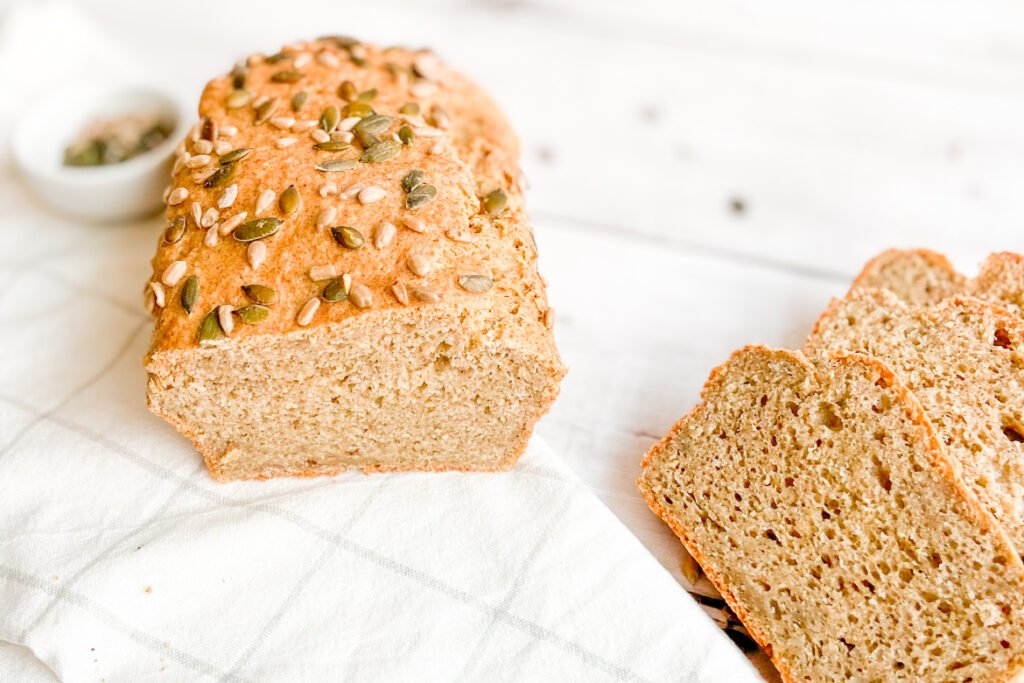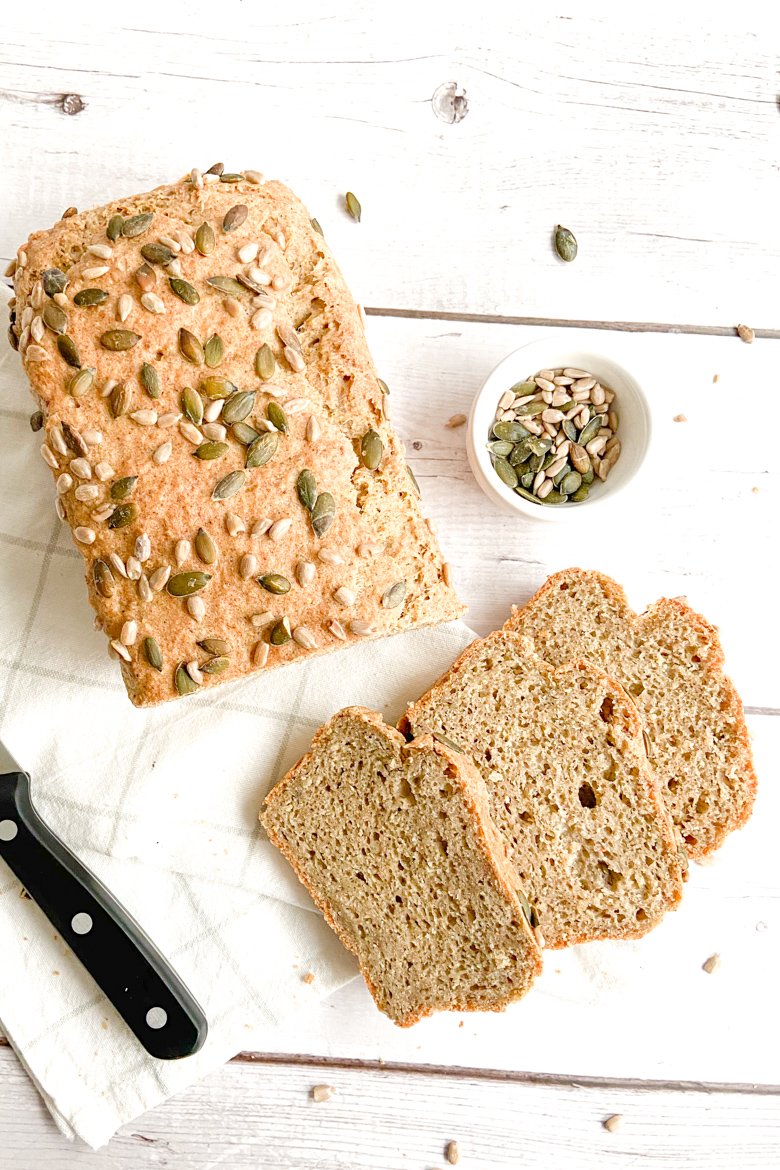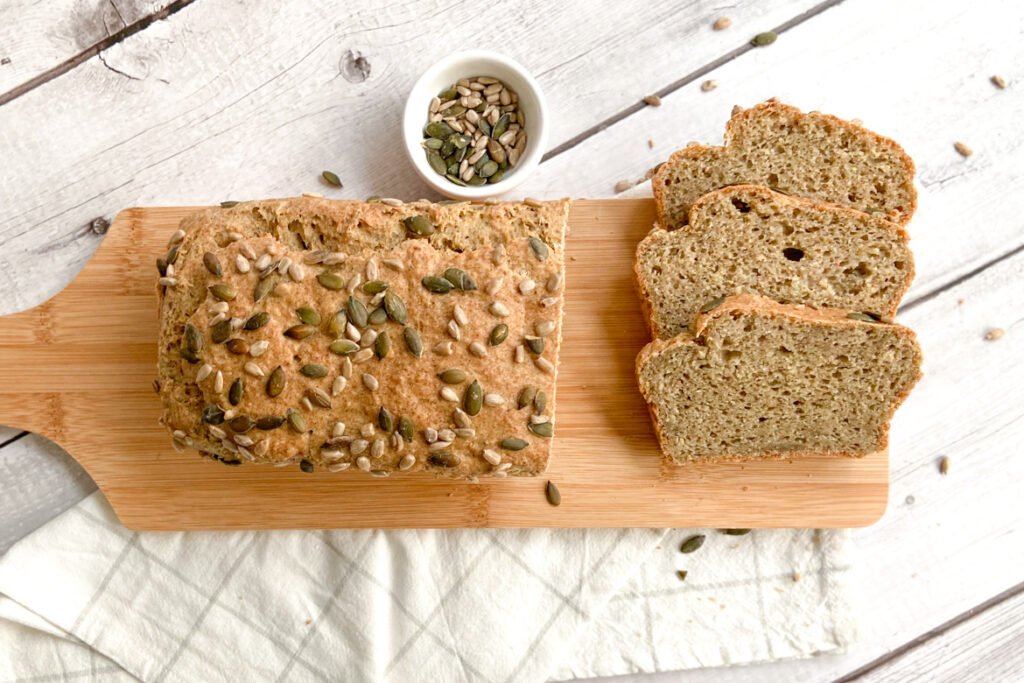This recipe for buckwheat bread only requires four types of gluten-free flours and a few other ingredients, making it a simple bread to bake. In addition, it doesn’t take long to complete compared to other bread recipes. The end result is a delicious gluten-free buckwheat bread that is light and fluffy on the inside and crispy on the outside!

In the quest for delicious and wholesome gluten-free bread, look no further than buckwheat bread. This unique and hearty bread not only satisfies your taste buds but also offers several health benefits.
Table of Contents
THE INGREDIENTS THAT MAKE IT GREAT
The big challenge of removing gluten from bakery products is retaining elasticity and softness. With some substitutions and tricks, you will learn that it’s possible to achieve this with gluten-free buckwheat bread.
- Plant-Based Milk: Plant-based milk, such as almond, coconut, or oat milk can be used in this recipe to add moisture and create a rich and creamy texture. It’s an excellent alternative to dairy milk for those with lactose intolerance or following a vegan diet.
- Eggs: Eggs play a crucial role in gluten-free baking. They provide structure, moisture, and help bind the ingredients together, making the bread light and fluffy. If you have an egg allergy or follow a vegan diet, you can experiment with egg substitutes like flaxseed or chia eggs, although I haven’t tried it yet in this recipe, so I cannot guarantee the same results.
- Extra Virgin Olive Oil: Extra virgin olive oil is a heart-healthy fat that adds a wonderful flavor and moistness to the bread. Also provides better slicing. It’s also rich in antioxidants and monounsaturated fats, which can support overall health.
- Gluten-Free Flour Mix: For those who require a gluten-free diet, this bread recipe uses a combination of gluten-free flours, with buckwheat flour being the primary ingredient. You can easily make your own blend at home, which I will teach you how to do later in this blog post. Buckwheat is an excellent choice for gluten-free baking as it does not contain gluten and can be substituted for regular flour in various baked goods such as cakes, bread, pies, and savory snacks. Additionally, buckwheat has high nutritional value and can be used as a rice substitute or added to salads and soups. When making the flour mix, make sure to use hulled buckwheat. To replicate the texture that gluten provides in traditional bread, it is essential to include flours like potato starch, tapioca starch, and flaxseed flour in this gluten-free flour blend. Also is very important to add xanthan gum and psyllium, which results in a soft, elastic, and fiber-rich gluten-free buckwheat bread.
- Xanthan gum: Xanthan gum is a useful ingredient that can substitute for gluten and hold things together. Gluten helps bread rise by capturing yeast bubbles and allowing them to expand, but xanthan gum can perform the same function and take the place of gluten.
- Psyllium: Psyllium is a great gluten substitute that adds elasticity to dough, allowing it to retain gas produced by yeast and expand during bulk fermentation. It also has the characteristics of traditional bread and is very healthy for our intestines.
- Brown Sugar: A small amount of brown sugar is added for a touch of sweetness and to begin the fermentation process.
- Ora-Pro-Nobis: Ora-Pro-Nobis is a protein-rich leafy green used in traditional Brazilian cuisine. It’s optional in this recipe but can add a unique flavor boost the nutritional profile of the bread and contribute to good intestinal function. Additionally, Ora-Pro-Nobis contains essential amino acids, such as lysine and tryptophan, as well as fiber, phosphorus, calcium, iron, and vitamins C, A, and B complex. These nutritional benefits make it a popular choice for those who are interested in a sustainable and varied diet. You can use Ora-Pro-Nobis in powder form to enrich cakes, breads, and pasta, which will give these recipes a greenish tone. Alternatively, you can consume the leaves in salads, soup, or mixed with rice.
- Dry Yeast: Yeast is the magical ingredient responsible for the bread’s rise and airy texture. Make sure to use gluten-free yeast to keep the bread entirely gluten-free. In this recipe, you don’t need to activate the yeast beforehand.
- Sea Salt: Sea salt enhances the flavor of the bread and helps regulate the yeast’s activity.
- Sunflower Seed and Pumpkin Seeds: I enjoy incorporating sunflower seeds and pumpkin seeds into my diet because they offer a variety of health benefits. Both seeds contain healthy oils and nutrients that are essential for overall health. Sunflower seeds are particularly rich in essential fatty acids, vitamins, and minerals, including antioxidants and vitamin E. They are also a great source of B-group vitamins. Pumpkin seeds, on the other hand, are known to help with intestinal parasites and are rich in unsaturated fats. They are also high in fiber and provide a significant amount of nutrients such as magnesium and amino acids. Additionally, some components in these seeds may have positive effects on sleep, anxiety, mood, appetite, and pain. Overall, adding sunflower seeds and pumpkin seeds to your diet can be a great way to improve your health.

HOW TO MAKE THE GLUTEN-FREE FLOUR MIX FOR THIS RECIPE
If you want to make gluten-free buckwheat bread, you’ll first need to create a gluten-free flour mix. Combine the following ingredients in a bowl and mix them with a whisk:
– 300g buckwheat flour
– 263g potato starch
– 87g sweet tapioca starch
– 8g xanthan gum
– 5g flaxseed flour
– 5g psyllium
This mixture will produce around 700g of flour, enough to make two loaves of bread. You can either save the remaining mix for later or double the recipe to make two loaves right away.
HOW TO MAKE GLUTEN-FREE BUCKWHEAT BREAD
Here’s a simplified step-by-step guide to making your delicious gluten-free buckwheat bread:
- In a bowl, combine all the dry ingredients (flour, sugar, ora-pro-nobis, (if using), and yeast).
- In a separate bowl, whisk the milk, eggs, extra virgin olive oil, and sea salt. Mix well.
- Gradually add the gluten-free flour mix to the wet ingredients, stirring continuously to create a smooth batter.
- Add the salt (add the salt to not kill the yeast) and stir until everything is well combined. (The batter, which resembles thick cake batter, it will be a bit runny. The reason the dough is more on a liquid side because buckwheat absorbs more liquids.)
- Pour the batter into a greased and lined bread pan. Then use a wet spoon to help smooth the top of the dough. Sprinkle some of the sunflower seeds and pumpkin seeds over the dough.
- Cover the pan with a clean kitchen towel and let it rise in a warm place for about 30-45 minutes, or until the dough has doubled in size.
- Preheat your oven to 180°C (350°F).
- Once the dough has risen, place it in the preheated oven and bake for approximately 30-35 minutes, or until the bread is golden brown and sounds hollow when tapped on the bottom.
- Remove the bread from the oven and let it cool in the pan for a few minutes before transferring it to a wire rack to cool completely.
- Wait for the bread to cool down for about one hour before slicing it.
- Slice, serve, and enjoy your homemade gluten-free buckwheat bread!








TIPS FOR GLUTEN-FREE BREAD RECIPE
- To ensure your bread is fully baked, insert a toothpick and check if it comes out clean, as some ovens display incorrect temperatures.
- Once you’ve finished baking, it’s important to let the bread rest in the pan for 10-15 minutes. After that, remove it from the pan and place it on a wire rack. If you don’t take the bread out of the pan, it will start to collect moisture at the bottom.
- Remember to allow the buckwheat bread to cool down for about an hour before cutting it. Gluten-free flours tend to turn gelatinous when still hot. Allowing the bread to cool completely will ensure that the flour is cooked thoroughly, resulting in perfectly baked buckwheat bread.
- It’s best to use a good bread knife and slice the crust slowly to prevent crumbling when cutting this bread.

HEALTH BENEFITS OF GLUTEN-FREE BUCKWHEAT BREAD
Now, let’s dive into the health benefits of enjoying gluten-free buckwheat bread:
1. Gluten-Free Goodness: As the name suggests, this bread is entirely gluten-free. For individuals with celiac disease or gluten sensitivity, it provides a safe and delicious alternative to traditional wheat-based bread.
2. High in Fiber: Buckwheat flour is naturally high in fiber, promoting digestive health and aiding in regular bowel movements. A diet rich in fiber is also associated with a reduced risk of heart disease.
3. Rich in Essential Nutrients: Buckwheat is a nutrient powerhouse, containing essential vitamins and minerals like magnesium, manganese, and B vitamins. These nutrients play a crucial role in maintaining overall health and well-being.
4. Heart-Healthy Fats: The use of extra virgin olive oil adds heart-healthy monounsaturated fats to the bread, which can help improve cholesterol levels and reduce the risk of cardiovascular disease.
5. Protein Source: Buckwheat is a good source of plant-based protein, making this bread a suitable option for vegans and vegetarians. Protein is essential for muscle repair and overall body function.
6. Low Glycemic Index: Buckwheat has a low glycemic index (GI), which means it has a minimal impact on blood sugar levels. This can be beneficial for individuals looking to manage their blood sugar.

BEST WAY TO ENJOY GLUTEN-FREE BUCKWHEAT BRAD
Gluten-free buckwheat bread can be enjoyed in various delicious ways. Here are some of the best ways to consume it:
- Toasted with Spread: One of the simplest and most satisfying ways to enjoy gluten-free buckwheat bread is by toasting slices and spreading your favorite toppings. Try it with almond butter, peanut butter, hummus, or avocado for a nutritious and filling snack or breakfast.
- Sandwiches: Use gluten-free buckwheat bread as a base for your favorite sandwiches. Load it up with fresh veggies, lean proteins like turkey or chicken, and your preferred condiments for a satisfying and healthy meal.
- French Toast: Turn gluten-free buckwheat bread into a delightful French toast. Dip slices in a mixture of eggs (or egg substitute for a vegan option), plant-based milk, and a dash of cinnamon, then cook them on a hot griddle until golden brown. Top with fresh berries and a drizzle of maple syrup for a special breakfast treat.
- Breadcrumbs: Grind up stale gluten-free buckwheat bread into breadcrumbs and use them to coat chicken, fish, or vegetables before baking or frying. They’ll add a unique flavor and texture to your dishes.
- Croutons: Cube gluten-free buckwheat bread, toss it with olive oil and your favorite seasonings, then bake until crispy. These homemade croutons are perfect for adding crunch to salads or soups.
- Open-Faced Sandwiches: Create colorful and flavorful open-faced sandwiches by topping toasted buckwheat bread with ingredients like hummus, roasted vegetables, sun-dried tomato paste, goat cheese, and fresh herbs.
- Bruschetta: Make gluten-free buckwheat bruschetta by grilling or toasting slices and topping them with diced tomatoes, basil, garlic, olive oil, balsamic vinegar, and a sprinkle of salt and pepper.
- Dipping Bread: Serve slices of gluten-free buckwheat bread alongside a selection of dips, such as olive tapenade, guacamole, or tzatziki, for a tasty appetizer.
- As a Side: Enjoy it as a side with hearty soups, stews, or chili. Its dense texture and robust flavor complement these dishes perfectly.
- Bread Pudding: Transform your gluten-free buckwheat bread into a rich and comforting bread pudding dessert. Combine it with eggs, milk, sugar, and your choice of add-ins like raisins or chocolate chips. Bake until it’s golden and set.
Experiment with these ideas to discover your favorite way to enjoy gluten-free buckwheat bread. Its earthy flavor and versatility make it a fantastic addition to your gluten-free and overall culinary repertoire.

STORAGE OF GLUTEN-FREE BUCKWHEAT BRAD
Remember to store your gluten-free buckwheat bread properly to maintain its freshness. If you have leftovers, wrap the bread in plastic wrap and store it in an airtight container at room temperature for 2-3 days. However, refrigeration can extend its shelf life.
A helpful tip is to slice and freeze your buckwheat bread so that you can enjoy it whenever you like! Once you’ve baked and allowed your bread to cool, slice it and separate the portions you want to freeze. Put them in a bag or freezer container and store in the freezer for up to three months. To defrost, simply leave the bread at room temperature. This way, you’ll always have fresh buckwheat bread on hand.

With this recipe, you can savor the delightful taste and numerous health benefits of gluten-free buckwheat bread. Whether you follow a gluten-free diet or simply appreciate a wholesome loaf, this bread is sure to become a staple in your kitchen. Plus, the flexibility to customize it with your favorite ingredients makes it an even more delightful addition to your culinary repertoire. Happy baking!

Gluten-Free Buckwheat Bread
Equipment
- Bread pan 8x4in/20x10cm
- 2 Large Bowls
- Kitchen scale
- Spatula
- Parchment paper
Ingredients
- 1 cup plant-based milk
- 3 eggs
- ¼ cup of extra virgin olive oil
- 2 cups (300g/10.5oz) gluten-free flour mix, (see notes)
- ½ tbsp brown sugar, (adjust to taste)
- ½ tbsp powdered or fresh ora-pro-nobis , (optional)
- 1 tbsp (10g/0.3oz) dry yeast
- 1 tsp sea salt
- Sunflour seed and pumpkin seeds, to sprinkle on top
Instructions
- In a bowl, combine all the dry ingredients (2 cups (300g/10.5oz) gluten-free flour mix, ½ tbsp brown sugar, ½ tbsp powdered or fresh ora-pro-nobis , (if using), and 1 tbsp (10g/0.3oz) dry yeast).
- In a separate bowl, whisk the 1 cup plant-based milk, 3 eggs, and ¼ cup of extra virgin olive oil. Mix well.
- Gradually add the dry ingredients to the wet ingredients, stirring continuously to create a smooth batter.
- Add the 1 tsp sea salt (add the salt last to not kill the yeast) and stir until everything is well combined.
- Pour the batter into a greased and lined bread pan. Then use a wet spoon to help smooth the top of the dough. Sprinkle some of the sunflower seeds and pumpkin seeds over the dough.
- Cover the pan with a clean kitchen towel and let it rise in a warm place for about 30-45 minutes, or until the dough has doubled in size.
- Preheat your oven to 180°C (350°F).
- Once the dough has risen, place it in the preheated oven and bake for approximately 30-35 minutes, or until the bread is golden brown and sounds hollow when tapped on the bottom.
- Remove the bread from the oven and let it cool in the pan for a few minutes before transferring it to a wire rack to cool completely.
- Wait for the bread to cool down for about one hour before slicing it.
- Slice, serve, and enjoy your homemade gluten-free buckwheat bread!
Notes
- 300g buckwheat flour
- 263g potato starch
- 87g sweet tapioca starch
- 8g xanthan gum
- 5g flaxseed flour
- 5g psyllium
